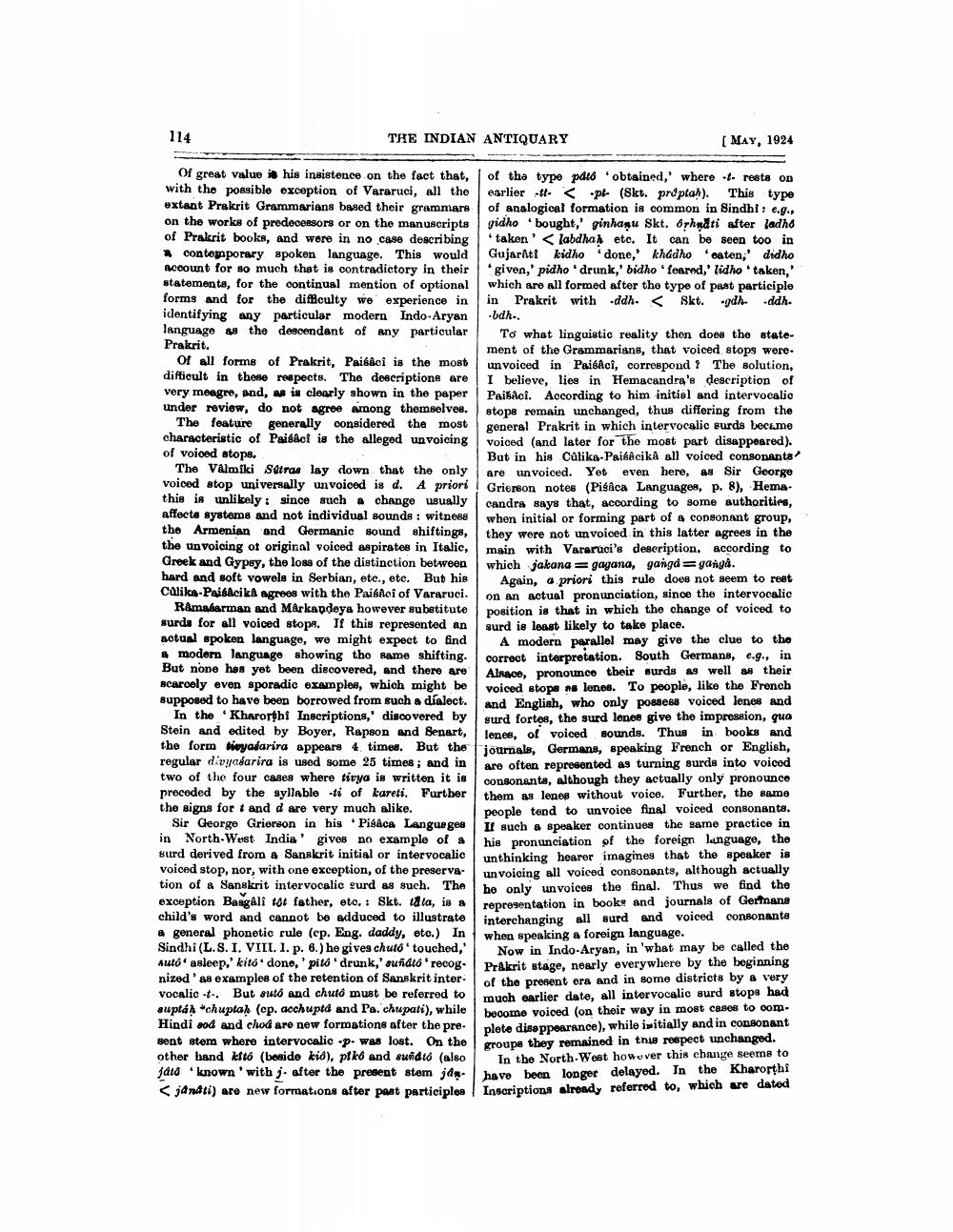________________
114
THE INDIAN ANTIQUARY
Of great value is his insistence on the fact that, with the possible exception of Vararuci, all the extant Prakrit Grammarians based their grammars on the works of predecessors or on the manuscripts of Prakrit books, and were in no case describing a contemporary spoken language. This would account for so much that is contradictory in their statements, for the continual mention of optional forms and for the difficulty we experience in identifying any particular modern Indo-Aryan language as the descendant of any particular Prakrit.
Of all forms of Prakrit, Paisaci is the most difficult in these respects. The descriptions are very meagre, and, as is clearly shown in the paper under review, do not agree among themselves.
The feature generally considered the most characteristic of Paisâct is the alleged unvoicing of voiced stops.
The Valmiki Satras lay down that the only voiced stop universally unvoiced is d. A priori this is unlikely: since such a change usually affects systems and not individual sounds: witness the Armenian and Germanic sound shiftings, the unvoicing of original voiced aspirates in Italic, Greek and Gypsy, the loss of the distinction between hard and soft vowels in Serbian, etc., etc. But his Calika-Paisacika agrees with the Paisaci of Vararuci.
Ramasarman and Markandeya however substitute surds for all voiced stops. If this represented an actual spoken language, we might expect to find a modern language showing the same shifting. But none has yet been discovered, and there are scarcely even sporadic examples, which might be supposed to have been borrowed from such a dialect.
In the Kharorthi Inscriptions,' discovered by Stein and edited by Boyer, Rapson and Senart, the form tieyadarira appears 4 times. But the regular divyasarira is used some 25 times; and in two of the four cases where tirya is written it is preceded by the syllable ti of kareti. Further the signs for t and d are very much alike.
[MAY, 1924
of the type páté obtained,' where t rests on earlier tt<pt (Skt. proptaḥ). This type of analogical formation is common in Sindhi: e.g., gidho bought,' ginhanu Skt. orhadti after ladho 'taken'<labdhaḥ etc. It can be seen too in Gujarati kidho 'done,' khádho 'eaten,' didho 'given,' pidho 'drunk,' bidho 'feared,' lidho 'taken,' which are all formed after the type of past participle in Prakrit with ddh. < Skt. gdh ddh. -bdh..
To what linguistic reality then does the statement of the Grammarians, that voiced stops were. unvoiced in Paisâci, correspond? The solution, I believe, lies in Hemacandra's description of Paisaci. According to him initial and intervocalic stops remain unchanged, thus differing from the general Prakrit in which intervocalic surds became voiced (and later for the most part disappeared). But in his Cûlika-Paisâcikâ all voiced consonants are unvoiced. Yet even here, as Sir George Grierson notes (Pisaca Languages, p. 8), Hemacandra says that, according to some authorities, when initial or forming part of a consonant group, they were not unvoiced in this latter agrees in the main with Vararuci's description, according to which jakana gagana, gangd=ganga.
Again, a priori this rule does not seem to rest on an actual pronunciation, since the intervocalic position is that in which the change of voiced to surd is least likely to take place.
A modern parallel may give the clue to the correct interpretation. South Germans, e.g., in Alsace, pronounce their surds as well as their voiced stops na lenes. To people, like the French and English, who only possess voiced lenes and surd fortes, the surd lenes give the impression, qua lenes, of voiced sounds. Thus in books and journals, Germans, speaking French or English, are often represented as turning surds into voiced consonants, although they actually only pronounce them as lenes without voice. Further, the same people tend to unvoice final voiced consonants. If such a speaker continues the same practice in his pronunciation of the foreign language, the unthinking hearer imagines that the speaker is un voicing all voiced consonants, although actually he only unvoices the final. Thus we find the representation in books and journals of Germans interchanging all surd and voiced consonants when speaking a foreign language.
Sir George Grierson in his 'Pisaca Languages in North-West India' gives no example of a surd derived from a Sanskrit initial or intervocalic voiced stop, nor, with one exception, of the preservation of a Sanskrit intervocalic surd as such. The exception Basgâli tôt father, etc.: Skt. tata, is a child's word and cannot be adduced to illustrate a general phonetic rule (cp. Eng. daddy, etc.) In Sindhi (L.S. I. VIII. 1. p. 6.) he gives chutó' touched,' Auto' asleep,' kitó done,' pito' drunk,' suñátó recognized' as examples of the retention of Sanskrit intervocalic -t. But suto and chutó must be referred to suptáḥ chuptaḥ (ep. acchuptd and Pa, chupati), while Hindi sod and chod are new formations after the pre-plete disappearance), while initially and in consonant
Now in Indo-Aryan, in 'what may be called the Prakrit stage, nearly everywhere by the beginning of the present era and in some districts by a very much earlier date, all intervocalic surd stops had become voiced (on their way in most cases to com
groups they remained in this respect unchanged.
sent stem where intervocalic -p. was lost. On the other hand kitô (beside kió), ptkó and sundtó (also játa 'known' with j. after the present stem já <janati) are new formations after past participles
In the North-West however this change seems to have been longer delayed. In the Kharorthi Inscriptions already referred to, which are dated




